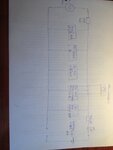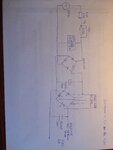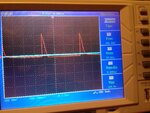pcurrius
Newbie level 5
Hello Everyone!
I've a degree in Power Electronics and I'm trying to build a charger with variable output 0-80V and 0-50A aproximatelly. Now I'm stucked with high currents to charge up the large capacitor that I have on the output.
I have made and I attach the simple schematics of what I'm having right now.
I'm controlling the output voltage by a potenciometer from the controller circuit that controlls the firing angle of the SCR (Silicon Controlled Rectifier).
In order to solve this I have tried to insert a 2K 5W Resistor in Series before the rectifier but it charges correctly the first DC bus but it gets too hot when I attach the output capacitor of 10.000uf 400V. Also I tried to start with the resistor and after couple of seconds that the DC capacitor is little charged jump the resistor but the main 220Vac 16A switch opens.
I'm aware that the circuit needs a transformer and output coil but I would like to make it work without and then make an step further. Perhaps I'm wrong and it won't work without the transformer and the output coil.
Any recomendations to follow up and make this circuit more stable?
Many thanks in advance.
I've a degree in Power Electronics and I'm trying to build a charger with variable output 0-80V and 0-50A aproximatelly. Now I'm stucked with high currents to charge up the large capacitor that I have on the output.
I have made and I attach the simple schematics of what I'm having right now.
I'm controlling the output voltage by a potenciometer from the controller circuit that controlls the firing angle of the SCR (Silicon Controlled Rectifier).
In order to solve this I have tried to insert a 2K 5W Resistor in Series before the rectifier but it charges correctly the first DC bus but it gets too hot when I attach the output capacitor of 10.000uf 400V. Also I tried to start with the resistor and after couple of seconds that the DC capacitor is little charged jump the resistor but the main 220Vac 16A switch opens.
I'm aware that the circuit needs a transformer and output coil but I would like to make it work without and then make an step further. Perhaps I'm wrong and it won't work without the transformer and the output coil.
Any recomendations to follow up and make this circuit more stable?
Many thanks in advance.


